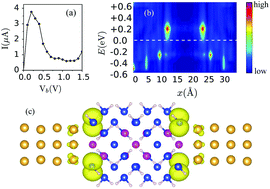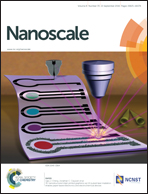Negative differential resistance in GeSi core–shell transport junctions: the role of local sp2 hybridization
Abstract
We report a theoretical investigation of nonlinear quantum transport properties of Au/GeSi/Au junctions. For GeSi semiconducting core–shell structures brought into contact with Au electrodes, a very unusual behavior is that the tunneling transport is on-resonance right at equilibrium. This resonance is not due to the alignment of a quantum level in GeSi to the electrochemical potential of Au, but due to the alignment of very sharp DOS features – hot spots, localized at the two Au/GeSi interfaces of the device. An applied bias voltage shifts the hot spots relative to each other which gives rise to substantial negative differential resistance (NDR). The hot spots localized at the two interfaces were found to be due to the unbonded pz orbital of a sp2 hybridized interface Si atom which is surrounded by three non-sp2 hybridized neighbors. The mechanism of inducing hot spots and NDR by a local structure unit is not limited to the GeSi. The results suggest an interesting scheme for constructing NDR devices by orbital manipulation, to be more explicit, for example, by designing local structural units having unbonded orbitals at the interfaces between electrodes and the central region of the transport junction.


 Please wait while we load your content...
Please wait while we load your content...